Mixed Electronic-Ionic Conductivity and Stability of Spark Plasma Sintered Graphene-Augmented Alumina Nanofibres Doped Yttria Stabilized Zirconia GAlN/YSZ Composites
Abstract
:1. Introduction
2. Experimental
2.1. Synthesis of YSZ/GAlN Composite Ceramics
2.2. GAlN/YSZ Composites Characterization
2.3. Electrochemical Testing of GAlN/YSZ
3. Results
3.1. The Structure of Sintered Composites
3.2. Electrochemical Studies of the Composite
4. Discussion
5. Conclusions
Supplementary Materials
Author Contributions
Funding
Informed Consent Statement
Data Availability Statement
Acknowledgments
Conflicts of Interest
References
- Morozov, S.V.; Novoselov, K.S.; Katsnelson, M.I.; Schedin, F.; Elias, D.C.; Jaszczak, J.A.; Geim, A.K. Giant Intrinsic Carrier Mobilities in Graphene and Its Bilayer. Phys. Rev. Lett. 2008, 100, 016602. [Google Scholar] [CrossRef] [PubMed] [Green Version]
- Shamshirgar, A.S.; Belmonte, M.; Tewari, G.C.; Hernández, R.E.R.; Seitsonen, J.; Ivanov, R.; Karppinen, M.; Miranzo, P.; Hussainova, I. Thermal Transport and Thermoelectric Effect in Composites of Alumina and Graphene-Augmented Alumina Nanofibers. Materials 2021, 14, 2242. [Google Scholar] [CrossRef] [PubMed]
- Ramírez, C.; Belmonte, M.; Miranzo, P.; Osendi, M.I. Applications of Ceramic/Graphene Composites and Hybrids. Materials 2021, 14, 2071. [Google Scholar] [CrossRef]
- Hosseini, F.S.; Laurencin, C.T. Advanced graphene ceramics and their future in bone regenerative engineering. Int. J. Appl. Ceram. Technol. 2022, 19, 893–905. [Google Scholar] [CrossRef]
- Porwal, H.; Grasso, S.; Reece, M.J. Review of graphene-ceramic matrix composites. Adv. Appl. Ceram. 2013, 112, 443–454. [Google Scholar] [CrossRef]
- Glukharev, A.G.; Konakov, V.G. Synthesis and properties of zirconia-graphene composite ceramics: A brief review. Rev. Adv. Mater. Sci. 2018, 56, 124–138. [Google Scholar] [CrossRef]
- Miranzo, P.; Belmonte, M.; Osendi, M.I. From bulk to cellular structures: A review on ceramic/graphene filler composites. J. Eur. Ceram. Soc. 2017, 37, 3649–3672. [Google Scholar] [CrossRef] [Green Version]
- Nieto, A.; Bisht, A.; Lahiri, D.; Zhang, C.; Agarwal, A. Graphene reinforced metal and ceramic matrix composites: A review. Int. Mater. Rev. 2017, 62, 241–302. [Google Scholar] [CrossRef]
- Glukharev, A.; Glumov, O.; Temnikova, M.; Shamshirgar, A.S.; Kurapova, O.; Hussainova, I.; Konakov, V. YSZ-rGO composite ceramics by spark plasma sintering: The relation between thermal evolution of conductivity, microstructure and phase stability. Electrochim. Acta 2021, 367, 137533. [Google Scholar] [CrossRef]
- Marinha, D.; Belmonte, M. Mixed-ionic and electronic conduction and stability of YSZ-graphene composites. J. Eur. Ceram. Soc. 2019, 39, 389–395. [Google Scholar] [CrossRef]
- Su, H.; Hu, Y.H. Recent advances in graphene-based materials for fuel cell applications. Energy Sci. Eng. 2021, 9, 958–983. [Google Scholar] [CrossRef]
- Solovev, A.V.; Starostin, G.N.; Zvonareva, I.A.; Tulenin, S.S.; Markov, V.F. Electrophoretic deposition of YSZ layers on pyrolytic graphite and a porous anode substrate based on NiO-YSZ. Chim. Techno Acta 2022, 9, article 20229425. [Google Scholar] [CrossRef]
- Tarutin, A.; Kasyanova, A.; Vdovin, G.; Lyagaeva, J.; Medvedev, D. Nickel-Containing Perovskites, PrNi0.4Fe0.6O3–δ and PrNi0.4Co0.6O3–δ, as Potential Electrodes for Protonic Ceramic Electrochemical Cells. Materials 2022, 15, 2166. [Google Scholar] [CrossRef] [PubMed]
- Dwivedi, S. Solid oxide fuel cell: Materials for anode, cathode and electrolyte. Int. J. Hydrogen Energy. 2020, 45, 23988–24013. [Google Scholar] [CrossRef]
- Jiang, S.P.; Chan, S.H. A review of anode materials development in solid oxide fuel cells. J. Mater. Sci. 2004, 39, 4405–4439. [Google Scholar] [CrossRef]
- Cowin, P.I.; Petit, C.T.G.; Lan, R.; Irvine, J.T.S.; Tao, S. Recent Progress in the Development of Anode Materials for Solid Oxide Fuel Cells. Adv. Energy Mater. 2011, 1, 314–332. [Google Scholar] [CrossRef]
- Golkhatmi, S.Z.; Asghar, M.I.; Lund, P.D. A review on solid oxide fuel cell durability: Latest progress, mechanisms, and study tools. Renew. Sustain. Energy Rev. 2022, 161, 112339. [Google Scholar] [CrossRef]
- Kurapova, O.Y.; Glukharev, A.G.; Glumov, O.V.; Kurapov, M.Y.; Boltynjuk, E.V.; Konakov, V.G. Structure and electrical properties of YSZ-rGO composites and YSZ ceramics, obtained from composite powder. Electrochim. Acta 2019, 230, 134573. [Google Scholar] [CrossRef]
- Hussainova, I.; Drozdova, M.; Pérez-Coll, D.; Rubio-Marcos, F.; Jasiuk, I.; Soares, J.A.N.T.; Rodríguez, M.A. Electroconductive composite of zirconia and hybrid graphene/alumina nanofibers. J. Eur. Ceram. Soc. 2017, 37, 3713–3719. [Google Scholar] [CrossRef]
- Poyato, R.; Osuna, J.; Morales-Rodríguez, A.; Gallardo-López, Á. Electrical conduction mechanisms in graphene nanoplatelet/yttria tetragonal zirconia composites. Ceram. Int. 2018, 44, 14610–14616. [Google Scholar] [CrossRef]
- Glukharev, A.; Glumov, O.; Smirnov, I.; Boltynjuk, E.; Kurapova, O.; Konakov, V. Phase Formation and the Electrical Properties of YSZ/rGO Composite Ceramics Sintered Using Silicon Carbide Powder Bed. Appl. Sci. 2021, 12, 190. [Google Scholar] [CrossRef]
- Wu, J.; Xu, W.; Dong, T.; Jin, M.; Zhou, Y. Self-assembly of graphene reinforced ZrO2 composites with deformation-sensing performance. Ceram. Int. 2022, 48, 32131–32142. [Google Scholar] [CrossRef]
- Gómez-Gómez, A.; Ramírez, C.; Llorente, J.; Garcia, A.; Moreno, P.; Reveron, H.; Chevalier, J.; Osendi, M.I.; Belmonte, M.; Miranzo, P. Improved crack resistance and thermal conductivity of cubic zirconia containing graphene nanoplatelets. J. Eur. Ceram. Soc. 2020, 40, 1557–1565. [Google Scholar] [CrossRef] [Green Version]
- Markandan, K.; Chin, J.K.; Tan, M.T.T. Recent progress in graphene based ceramic composites: A review. J. Mater. Res. 2017, 32, 84–106. [Google Scholar] [CrossRef] [Green Version]
- Cano-Crespo, R.; Moshtaghioun, B.M.; Gómez-García, D.; Moreno, R.; Domínguez-Rodríguez, A. Graphene or carbon nanofiber-reinforced zirconia composites: Are they really worthwhile for structural applications? J. Eur. Ceram. Soc. 2018, 38, 3994–4002. [Google Scholar] [CrossRef] [Green Version]
- Rincón, A.; Chinelatto, A.S.A.; Moreno, R. Tape casting of alumina/zirconia suspensions containing graphene oxide. J. Eur. Ceram. Soc. 2014, 34, 1819–1827. [Google Scholar] [CrossRef]
- Zeng, Z.; Liu, Y.; Guo, R.; Li, K. Friction and wear behaviours of in situ reduced graphene oxide reinforced zirconia ceramic. Int. J. Refract. Met. Hard Mater. 2019, 79, 164–170. [Google Scholar] [CrossRef]
- Zeng, Z.; Liu, Y.; Chen, W.; Li, X.; Zheng, Q.; Li, K.; Guo, R. Fabrication and properties of in situ reduced graphene oxide-toughened zirconia composite ceramics. J. Am. Ceram. Soc. 2018, 101, 3498–3507. [Google Scholar] [CrossRef]
- Kairi, M.I.; Dayou, S.; Kairi, N.I.; Bakar, S.A.; Vigolo, B.; Mohamed, A.R. Toward high production of graphene flakes—a review on recent developments in their synthesis methods and scalability. J. Mater. Chem. A 2018, 6, 15010–15026. [Google Scholar] [CrossRef] [Green Version]
- Su, J.; Teng, J. Recent progress in graphene-reinforced aluminum matrix composites. Front. Mater. Sci. 2021, 15, 79–97. [Google Scholar] [CrossRef]
- Muñoz-Ferreiro, C.; López-Pernía, C.; Gallardo-López, Á.; Poyato, R. Unravelling the optimization of few-layer graphene crystallinity and electrical conductivity in ceramic composites by Raman spectroscopy. J. Eur. Ceram. Soc. 2021, 41, 290–298. [Google Scholar] [CrossRef]
- Trusova, E.A.; Titov, D.D.; Afzal, A.M.; Abramchuk, S.S. Influence of Graphene Sheets on Compaction and Sintering Properties of Nano-Zirconia Ceramics. Materials 2022, 15, 7342. [Google Scholar] [CrossRef] [PubMed]
- Dusza, J.; Blugan, G.; Morgiel, J.; Kuebler, J.; Inam, F.; Peijs, T.; Reece, M.J.; Puchy, V. Hot pressed and spark plasma sintered zirconia/carbon nanofiber composites. J. Eur. Ceram. Soc. 2009, 29, 3177–3184. [Google Scholar] [CrossRef]
- Hussainova, I.; Baronins, J.; Drozdova, M.; Antonov, M. Wear performance of hierarchically structured alumina reinforced by hybrid graphene encapsulated alumina nanofibers. Wear 2016, 368–369, 287–295. [Google Scholar] [CrossRef]
- Fan, Y.; Jiang, W.; Kawasaki, A. Highly Conductive Few-Layer Graphene/Al2O3 Nanocomposites with Tunable Charge Carrier Type. Adv. Funct. Mater. 2012, 22, 3882–3889. [Google Scholar] [CrossRef]
- Drozdova, M.; Pérez-Coll, D.; Aghayan, M.; Ivanov, R.; Rodríguez, M.A.; Hussainova, I. Hybrid Graphene/Alumina Nanofibers for Electrodonductive Zirconia. Key Eng. Mater. 2016, 674, 15–20. [Google Scholar] [CrossRef]
- Kurapova, O.Y.; Konakov, V.G. Phase evolution in zirconia based systems. Rev. Adv. Mater. Sci. 2014, 36, 177–190. [Google Scholar]
- Aghayan, M.; Hussainova, I.; Gasik, M.; Kutuzov, M.; Friman, M. Coupled thermal analysis of novel alumina nanofibers with ultrahigh aspect ratio. Thermochim. Acta 2013, 574, 140–144. [Google Scholar] [CrossRef]
- PDF-2 (Powder Diffraction File) Database; International Centre for Diffraction Data: Newtown Square, PA, USA. 2021. Available online: https://www.icdd.com/pdf-2/ (accessed on 1 February 2022).
- Tyagi, B.; Sidhpuria, K.; Shaik, B.; Jasra, R.V. Synthesis of Nanocrystalline Zirconia Using Sol−Gel and Precipitation Techniques. Ind. Eng. Chem. Res. 2006, 45, 8643–8650. [Google Scholar] [CrossRef]
- Basahel, S.N.; Ali, T.T.; Mokhtar, M.; Narasimharao, K. Influence of crystal structure of nanosized ZrO2 on photocatalytic degradation of methyl orange. Nanoscale Res. Lett. 2015, 10, 1–13. [Google Scholar] [CrossRef] [Green Version]
- Cai, J.; Raptis, C.; Raptis, Y.S.; Anastassakis, E. Temperature dependence of Raman scattering in stabilized cubic zirconia. Phys. Rev. B 1995, 51, 201–209. [Google Scholar] [CrossRef] [PubMed]
- Childres, Y.P.; Jauregui, I.Y.; Park, L.A.; Caoa, W.; Chena, H. Raman spectroscopy of graphene and related materials. New Dev. Phot. Mater. Res. 2013, 1, 403–418. [Google Scholar]
- Voiry, D.; Yang, J.; Kupferberg, J.; Fullon, R.; Lee, C.; Jeong, H.Y.; Shin, H.S.; Chhowalla, M. High-quality graphene via microwave reduction of solution-exfoliated graphene oxide. Science 2016, 353, 1413–1416. [Google Scholar] [CrossRef] [Green Version]
- Shin, J.H.; Hong, S.H. Fabrication and properties of reduced graphene oxide reinforced yttria-stabilized zirconia composite ceramics. J. Eur. Ceram. Soc. 2014, 34, 1297–1302. [Google Scholar] [CrossRef]
- Bauerle, J.E. Study of solid electrolyte polarization by a complex admittance method. J. Phys. Chem. Solids. 1969, 30, 2657–2670. [Google Scholar] [CrossRef]
- Asadikiya, M.; Zhong, Y. Oxygen ion mobility and conductivity prediction in cubic yttria-stabilized zirconia single crystals. J. Mater. Sci. 2018, 53, 1699–1709. [Google Scholar] [CrossRef]
- Kurapova, O.Y.; Glumov, O.V.; Lomakin, I.V.; Golubev, S.N.; Pivovarov, M.M.; Krivolapova, J.V.; Konakov, V.G. Microstructure, conductivity and mechanical properties of calcia stabilized zirconia ceramics obtained from nanosized precursor and reduced graphene oxide doped precursor powders. Ceram. Int. 2018, 44, 15464–15471. [Google Scholar] [CrossRef]
- Guo, X. Can we achieve significantly higher ionic conductivity in nanostructured zirconia? Scr. Mater. 2011, 65, 96–101. [Google Scholar] [CrossRef]
- Novik, N.N.; Konakov, V.G.; IArchakov, I.Y. Zirconia and ceria based ceramics and nanoceramics—A review on electrochemical and mechanical properties. Rev. Adv. Mater. Sci. 2015, 40, 188–207. [Google Scholar]
- Chen, F.; Jin, D.; Tyeb, K.; Wang, B.; Han, Y.H.; Kim, S.; Schoenung, J.M.; Shen, Q.; Zhang, L. Field assisted sintering of graphene reinforced zirconia ceramics. Ceram. Int. 2015, 41, 6113–6116. [Google Scholar] [CrossRef]


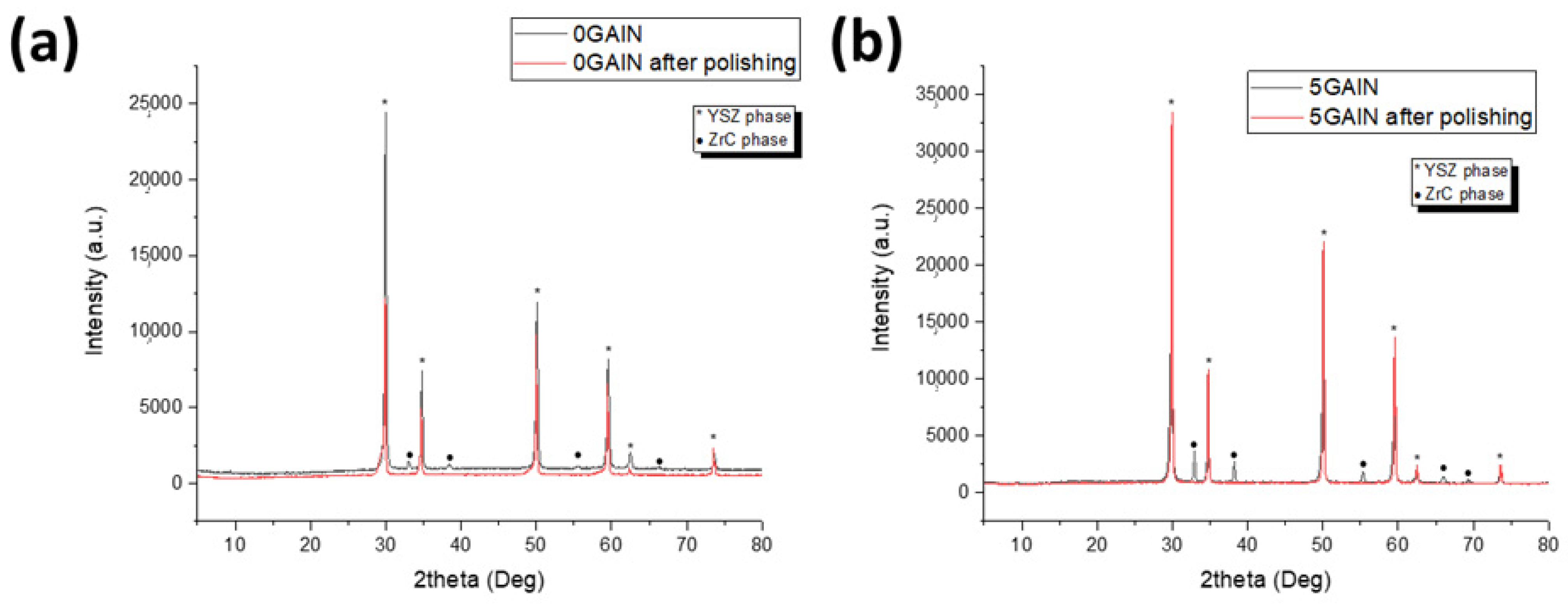

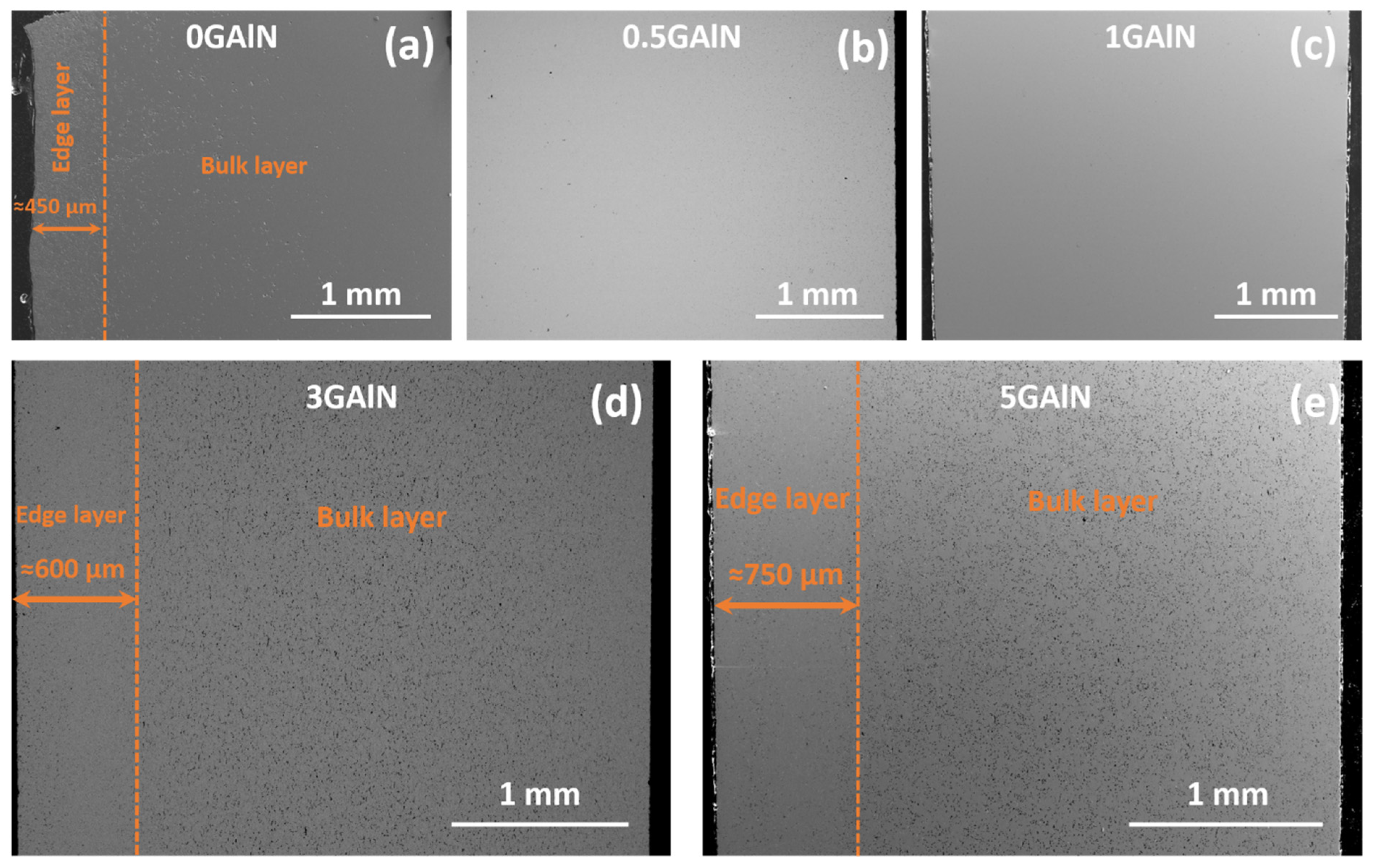

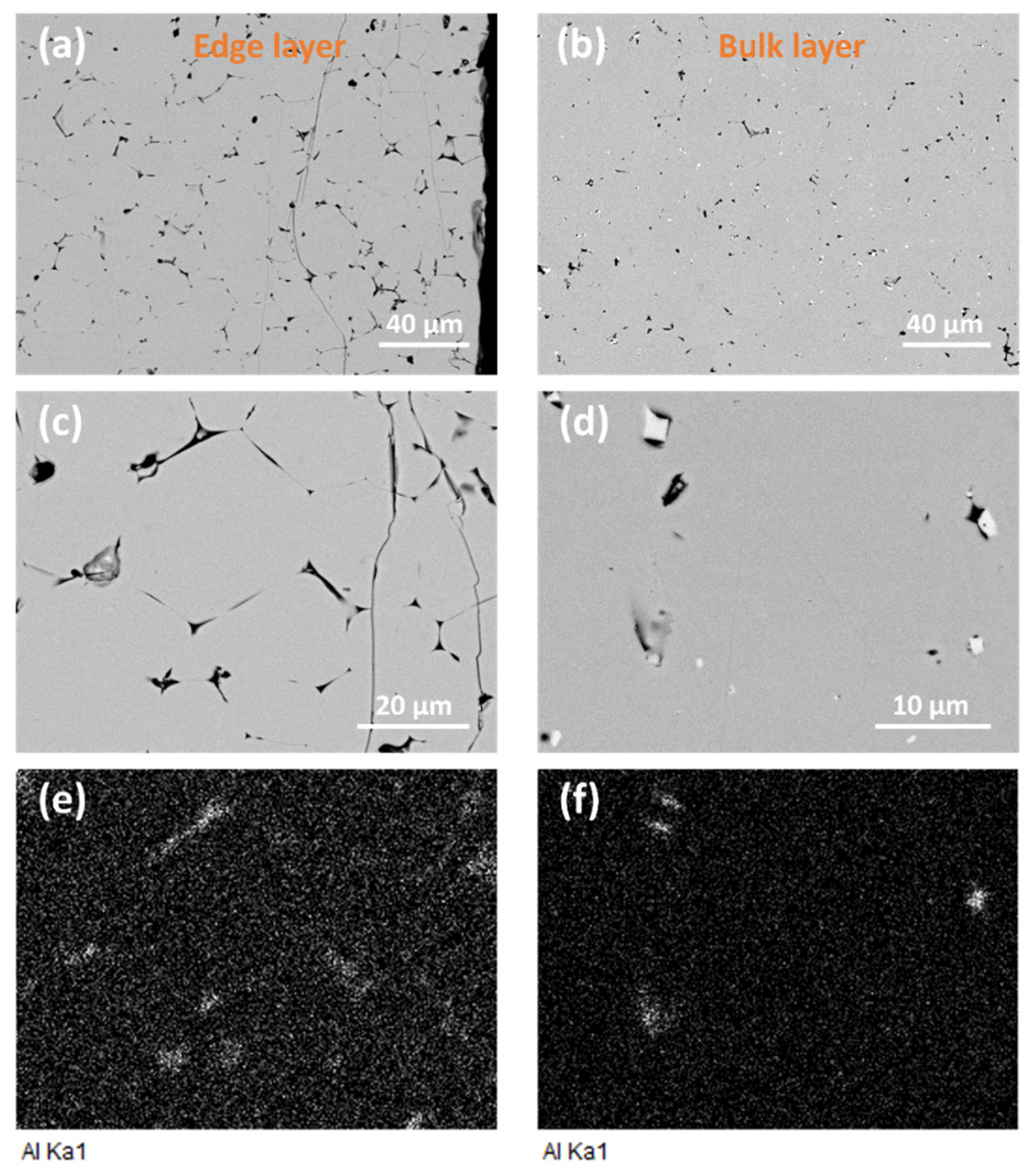
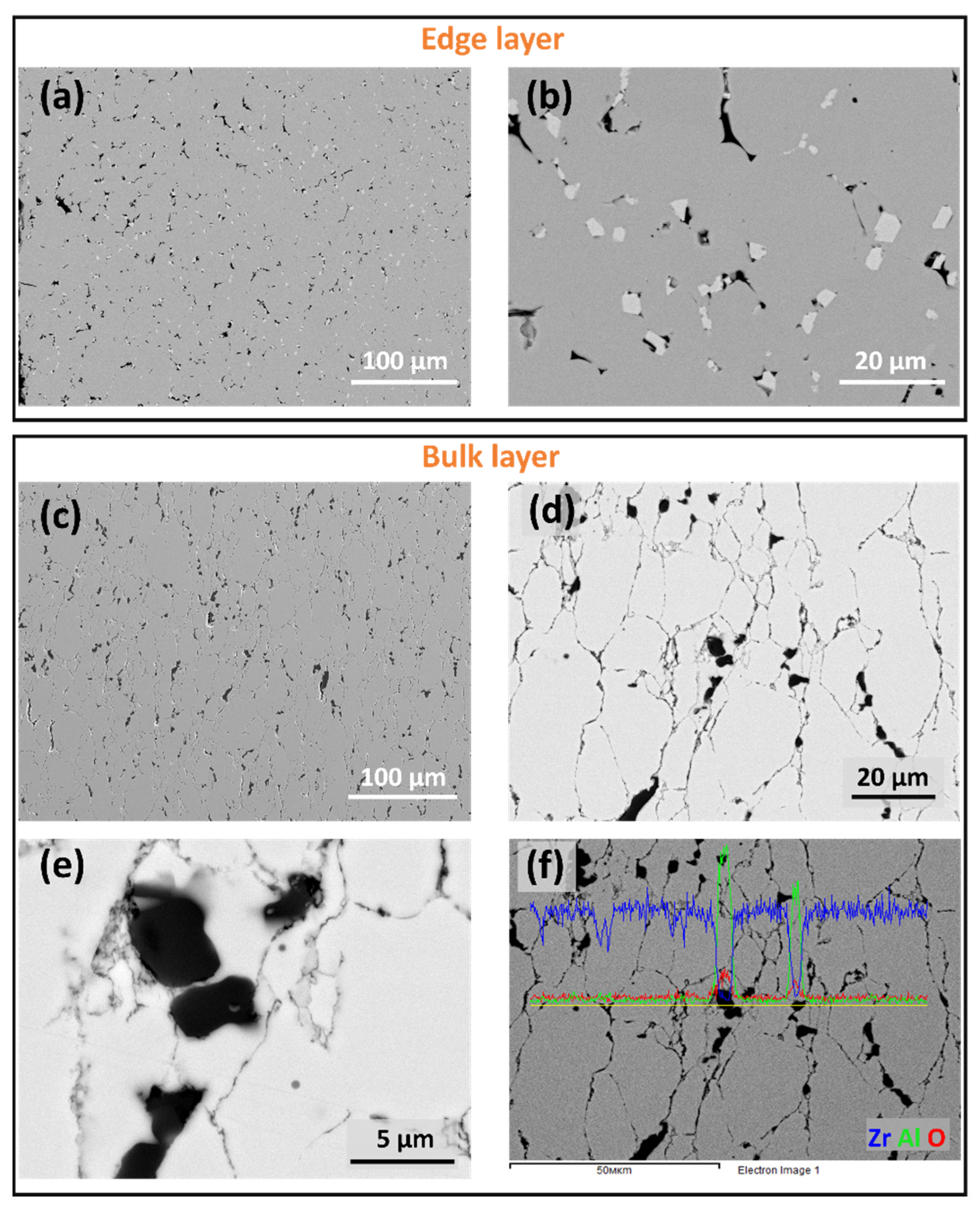
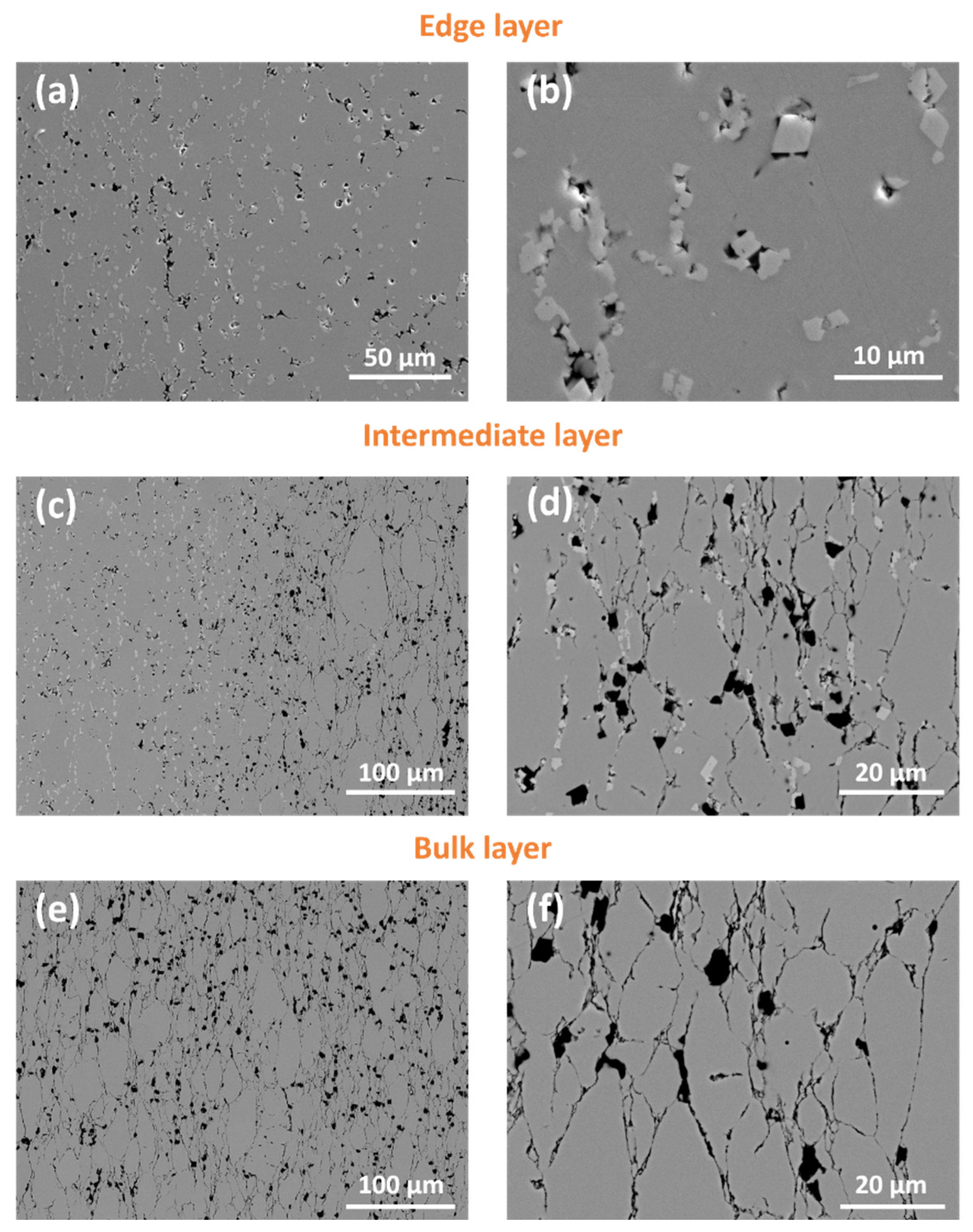


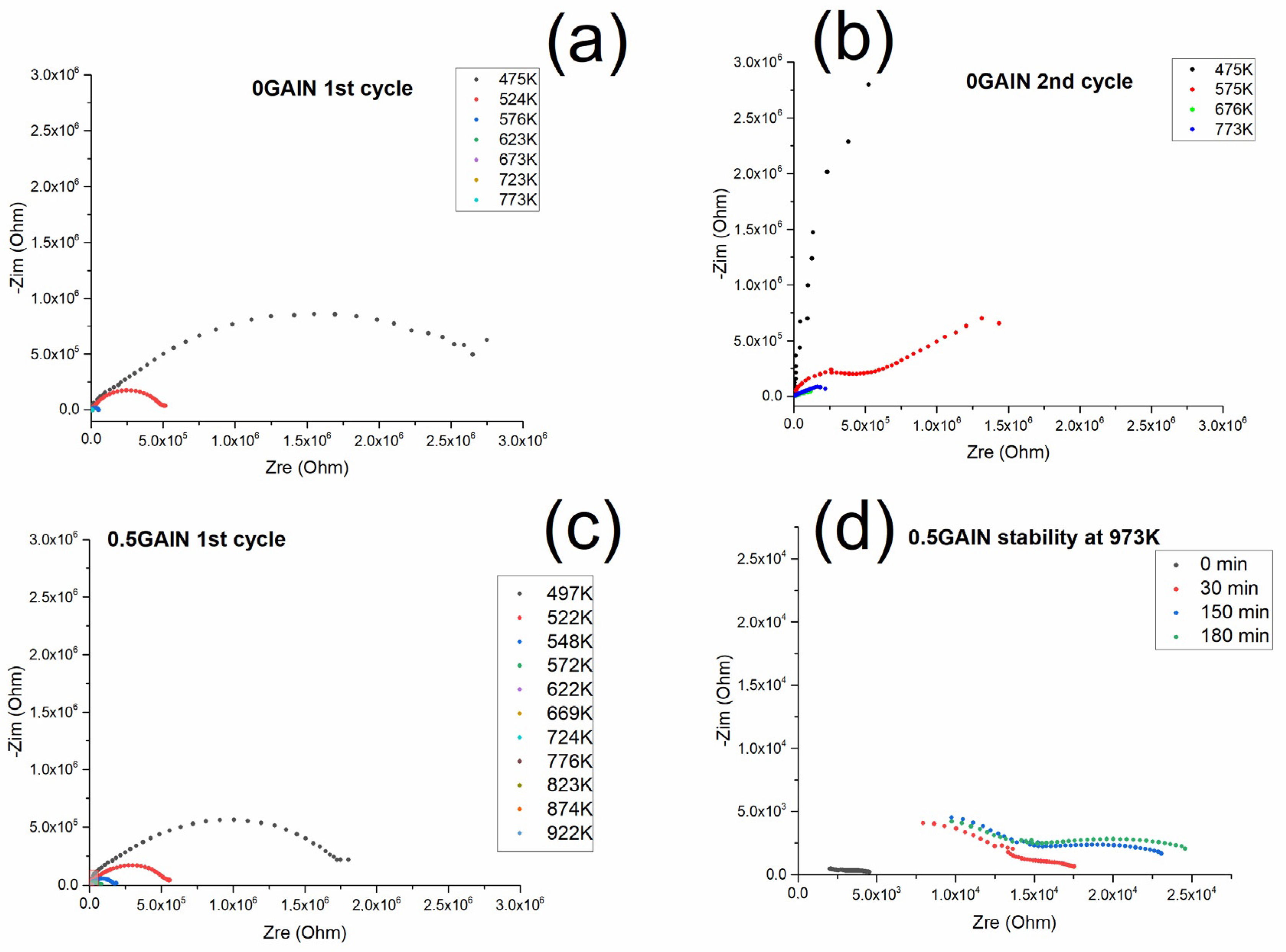
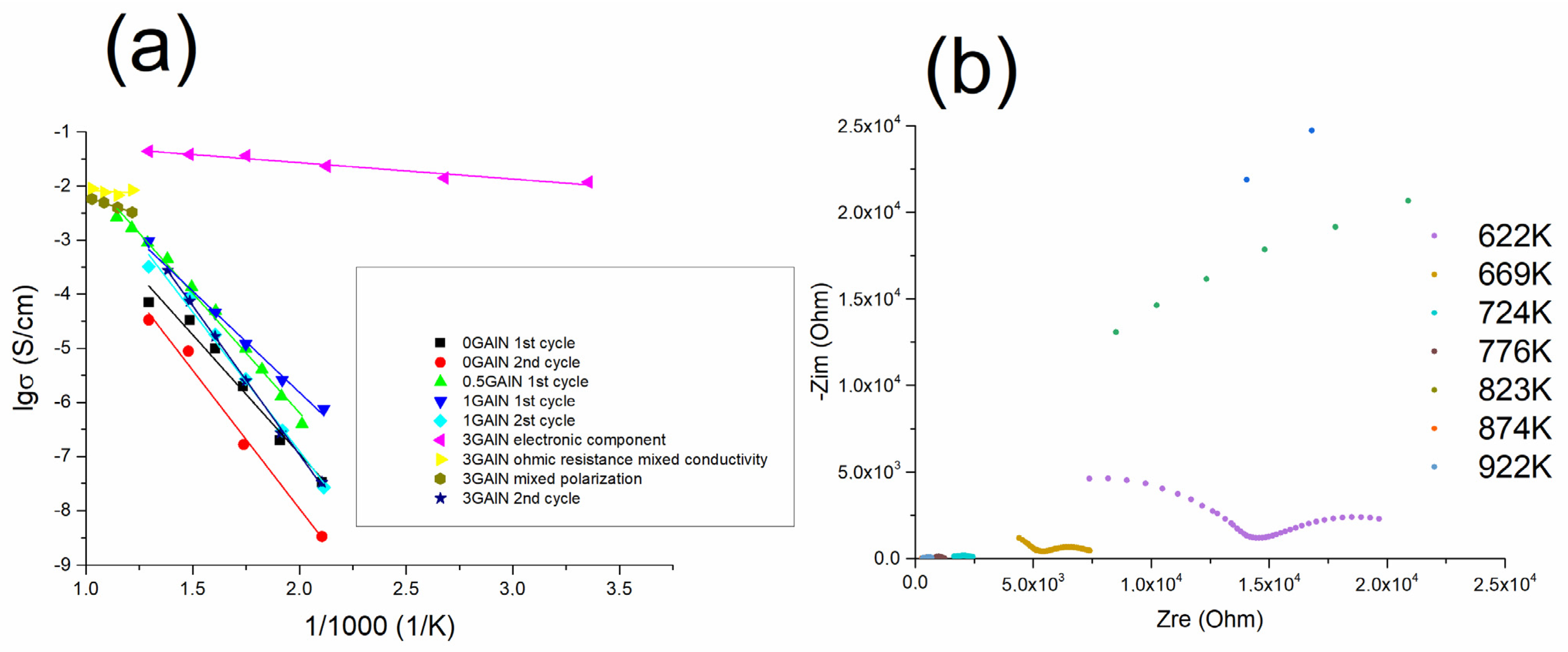

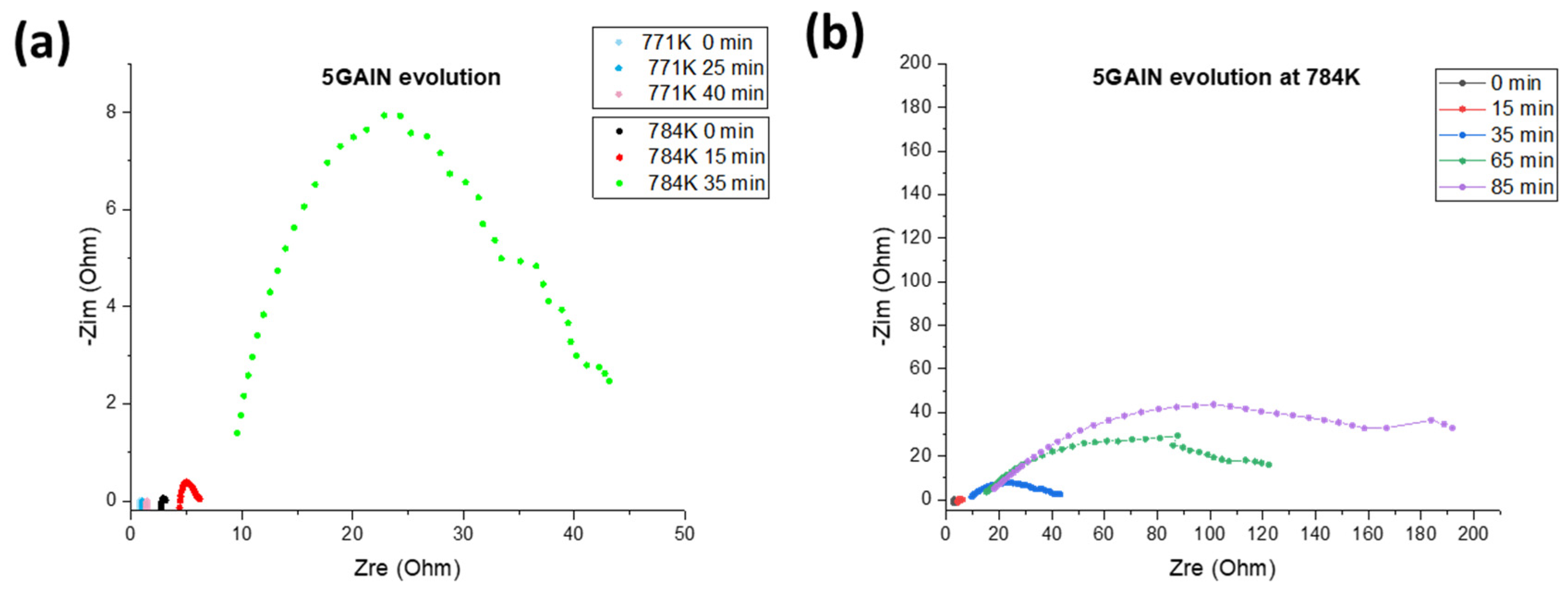

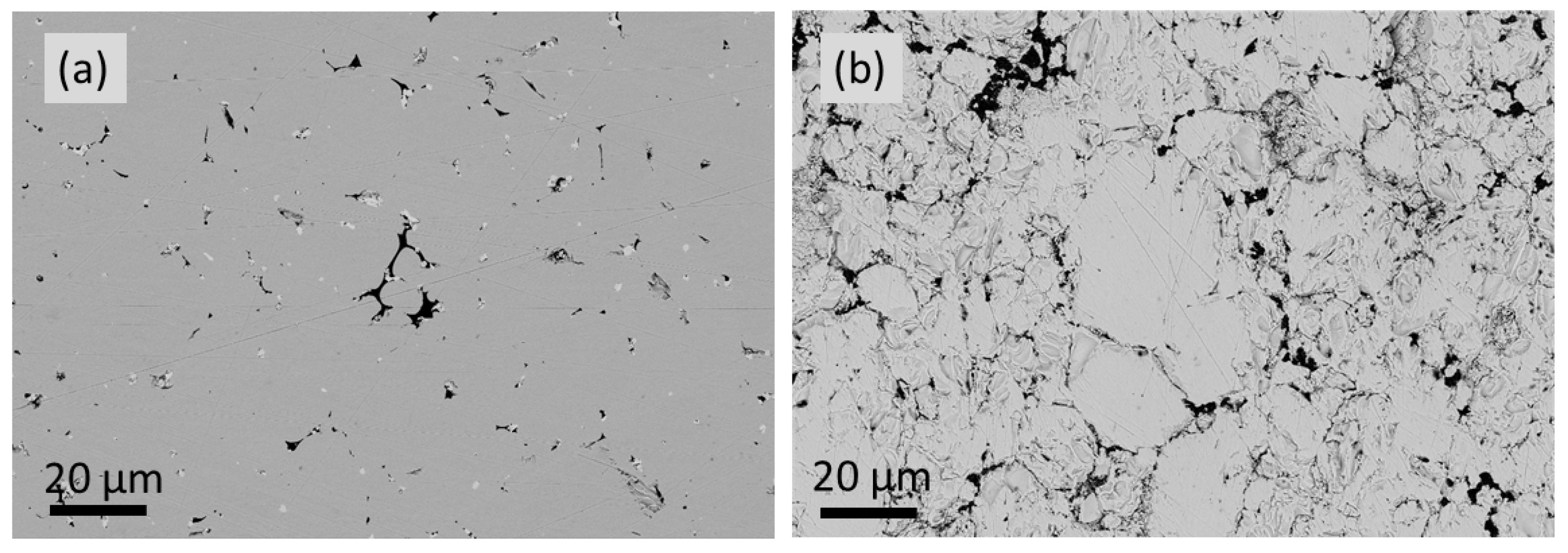
| Sample Label | 0 GAlN | 0.5 GAlN | 1 GAlN | 3 GAlN | 5 GAlN |
|---|---|---|---|---|---|
| Brutto-composition | 91ZrO2–9Y2O3 (mol.%, YSZ) | 99.5 wt.% YSZ + 0.5 wt.% GAlN | 99 wt.% YSZ + 1 wt.% GAlN | 97 wt.% YSZ + 3 wt.% GAlN | 95 wt.% YSZ + 5 wt.% GAlN |
| Label | Relative Density, % | Crystallinity, % | Average Crystallite Size dcryst, nm | ID/IG | I2D/IG |
|---|---|---|---|---|---|
| 0 GAlN | 99.4 ± 0.47 | 66 | 87 | - | - |
| 0.5 GAlN | 99.2 ± 0.07 | 69 | 89 | - | - |
| 1 GAlN | 99.4 ± 0.03 | 75 | 94 | 0.78 | 0.76 |
| 3 GAlN | 98.7 ± 0.01 | 77 | 97 | 0.79 | 0.87 |
| 5 GAlN | 98.9 ± 0.02 | 84 | 104 | 0.62 | 0.57 |
| Sample | 0 GAlN | 0.5 GAlN | 1 GAlN | 3 GAlN |
|---|---|---|---|---|
| Activation energy, eV First cycle | 0.99 | Total: 0.88 Grain boundaries 0.77 Grains 0.88 | 0.74 | Electronic component: 0.06 ohmic component: 0.2 polarization component: 0.26 |
| Activation energy, eV Second cycle | 1.01 | 1.11 | 1.11 | 1.1 |
| Temperature, K Conductivity, S/cm | 771 K | 784 K | |||
|---|---|---|---|---|---|
| Time, min | Conductivity, S/cm | Time, min | Conductivity, S/cm | ||
| 469 | 0.127 | 0 | 0.127 | 0 | 0.037 |
| 571 | 0.141 | 25 | 0.1 | 15 | 0.023 |
| 673 | 0.137 | 40 | 0.0709 | 35 | 0.011 |
| 720 | 0.132 | 65 | 0.0073 | ||
| 771 | 0.125 | 85 | 0.0062 | ||
| 798 | 0.0361 | ||||
| cooling to 298 | 2 × 10−8 | ||||
Disclaimer/Publisher’s Note: The statements, opinions and data contained in all publications are solely those of the individual author(s) and contributor(s) and not of MDPI and/or the editor(s). MDPI and/or the editor(s) disclaim responsibility for any injury to people or property resulting from any ideas, methods, instructions or products referred to in the content. |
© 2023 by the authors. Licensee MDPI, Basel, Switzerland. This article is an open access article distributed under the terms and conditions of the Creative Commons Attribution (CC BY) license (https://creativecommons.org/licenses/by/4.0/).
Share and Cite
Kurapova, O.; Glumov, O.; Smirnov, I.; Konakov, Y.; Konakov, V. Mixed Electronic-Ionic Conductivity and Stability of Spark Plasma Sintered Graphene-Augmented Alumina Nanofibres Doped Yttria Stabilized Zirconia GAlN/YSZ Composites. Materials 2023, 16, 618. https://doi.org/10.3390/ma16020618
Kurapova O, Glumov O, Smirnov I, Konakov Y, Konakov V. Mixed Electronic-Ionic Conductivity and Stability of Spark Plasma Sintered Graphene-Augmented Alumina Nanofibres Doped Yttria Stabilized Zirconia GAlN/YSZ Composites. Materials. 2023; 16(2):618. https://doi.org/10.3390/ma16020618
Chicago/Turabian StyleKurapova, Olga, Oleg Glumov, Ivan Smirnov, Yaroslav Konakov, and Vladimir Konakov. 2023. "Mixed Electronic-Ionic Conductivity and Stability of Spark Plasma Sintered Graphene-Augmented Alumina Nanofibres Doped Yttria Stabilized Zirconia GAlN/YSZ Composites" Materials 16, no. 2: 618. https://doi.org/10.3390/ma16020618
APA StyleKurapova, O., Glumov, O., Smirnov, I., Konakov, Y., & Konakov, V. (2023). Mixed Electronic-Ionic Conductivity and Stability of Spark Plasma Sintered Graphene-Augmented Alumina Nanofibres Doped Yttria Stabilized Zirconia GAlN/YSZ Composites. Materials, 16(2), 618. https://doi.org/10.3390/ma16020618







